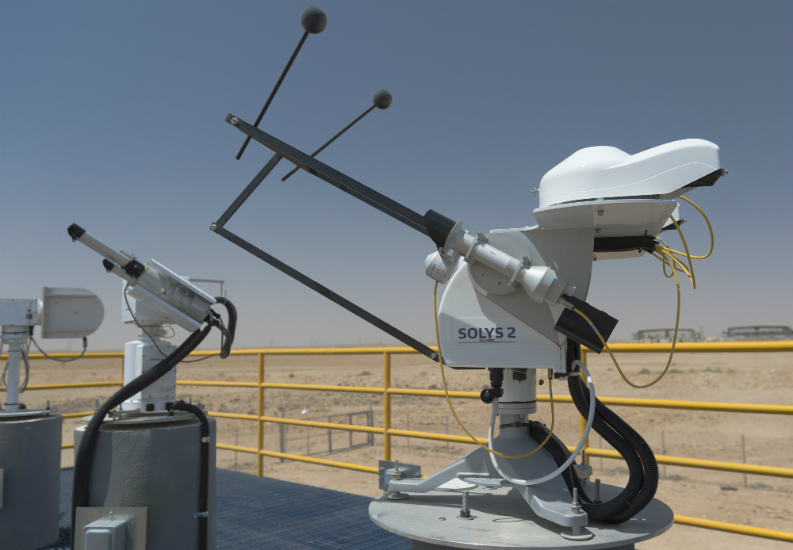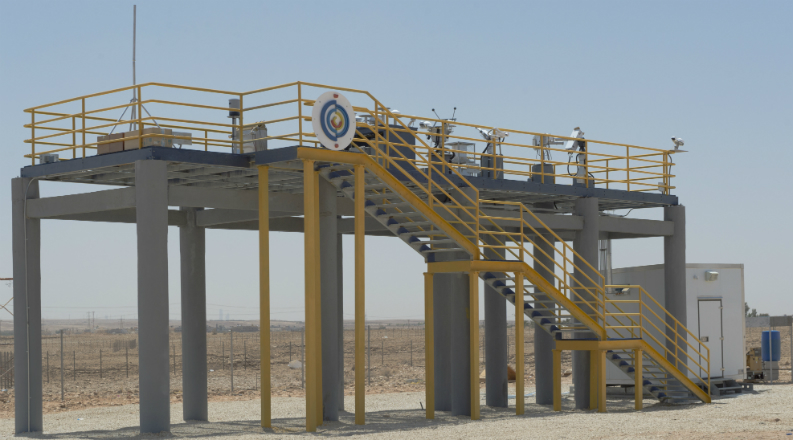In the light of the enormous solar energy potential of Saudi Arabia, with an average of 3,000 hours of sunshine per year, one of the first technical programs undertaken by K.A.CARE is the Renewable Resource Monitoring and Mapping (RRMM) Program to develop a highly accurate Solar Atlas for the Kingdom of Saudi Arabia. 59 solar resource monitoring stations will be deployed in 2014 and 2015 to capture the spatial and temporal variability over the Kingdom. The majority of these stations are equipped with Kipp & Zonen instruments.
The main objective of our visit was to establish a long-term relationship with the customer and to review progress on the implementation of the solar monitoring stations. The first day started with a visit to the Al Uyaynah site near Riyadh, accompanied by Mr. Shibli and Mr. Gasim of K.A.CARE. The site hosts a ‘Tier 1 Research Station’ that complies with the measurement practices described in the World Meteorological Organization (WMO) Baseline Surface Radiation Network (BSRN) Operations Manual.
There are over 20 Tier 1 research stations currently in the process of being commissioned and validated. These stations include a SOLYS 2 sun tracker equipped for the measurement of direct, diffuse, global and down-welling far infrared radiation. Instrumentation includes two CMP 21 or CMP 22 pyranometers and a CGR 4 pyrgeometer, all fitted with the CVF4 ventilation unit, and a CHP 1 pyrheliometer. 12 of the stations have POM-02 sky radiometers for aerosol optical depth measurements.

Tier 1 installations also include UVS-AB-T and PQS 1 radiometers, a ventilated pyranometer for tilted global radiation and an automatic weather station. Most sites also have a pyranometer and pyrgeometer for reflected solar and up-welling far infrared radiation. More information on the station tiers and instrumentation can be found on the K.A.CARE website at rratlas.kacare.gov.sa/RRMMPublicPortal/?q=en/Solar/StationTiers
Foeke and I were very impressed with the excellent quality of the construction of the platform at Al Uyaynah and the execution of the project to provide ideal and safe measurement conditions. The platform is big enough to host a large set of high-level equipment for measuring solar radiation, meteorological parameters and atmospheric properties, and it is high enough that most wind-driven sand will pass underneath.
Mr. Shibli and Mr. Gasim appreciated the value of Kipp & Zonen’s instruments and involvement. They clarified that equipment will be maintained and cleaned from dust on a regular basis. The platform systems will be powered with a gasoline generator, as Al Uyaynah is a remote site and solar power would have required a huge number of solar panels and batteries.
On the second day there was a meeting at K.A.CARE with Messrs. Shibli, Gasim and other colleagues. The theme of the meeting was to establish how Kipp & Zonen can help K.A.CARE to ensure long-term operability of the Kipp & Zonen instruments in the network through service and calibration. The meeting also featured discussions on future requirements and strengthened the established relationship between K.A.CARE and Kipp & Zonen.
On behalf of Kipp & Zonen, we would like to thank K.A.CARE, Mr. Shibli and his colleagues for their warm welcome, time and great hospitality. This brief, yet rich, experience illustrated so much positivity
Article by Kamal Sabra, Kipp & Zonen France
